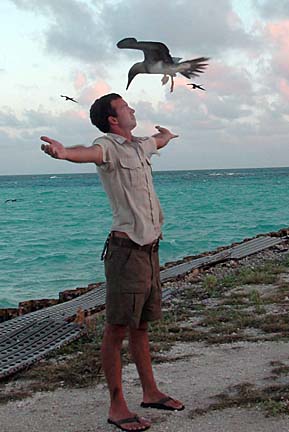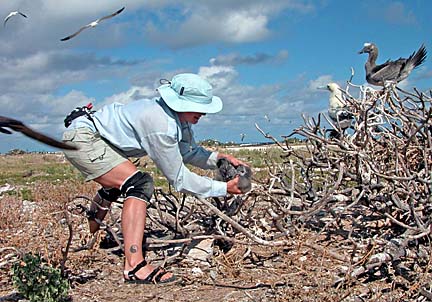
Biologist Alex Wegmann, with the U.S. Fish and Wildlife Service, makes himself available to a juvenile red-footed booby interested in landing on him. When learning to fly, these young birds practice landing on everything, including people.
Workers find
comforts of home
When I heard the word 'barracks,'" says Tern Island manager Jennifer Tietjen, "I imagined one big room packed with people, each of us having a bed and a little foot locker. But when I walked in here, my first thought was, 'This is just like home.'"
Managed by the U.S. Fish and Wildlife Service, 34-acre Tern Island is the main biological field station of the Hawaiian Islands National Wildlife Refuge. Thirty-four acres sounds minuscule, but the island stretches out in a long, narrow rectangle, making it look and feel bigger than it is.
"I imagined riding a bicycle around and around in circles on a little desert island," Tietjen said. "I certainly didn't expect a half-mile long jogging track (the airstrip) and a house with all the comforts of home."
Tietjen is not the only one surprised by the feeling of space on the island and its comfortable living quarters, formerly a U.S. Coast Guard barracks. Volunteer biologist Christy Hand was amazed workers get hot, fresh-water showers each day.
"Then there are computers and a DVD player," she says.
She picks up a pillow from the armchair next to her.
"And cushions even."
FWS manager Jennifer Tietjen enjoys a spectacular view of the ocean and Tern Island's wildlife as she rides a stationary bike in the island's exercise room. The screen keeps the birds from nesting inside.
Both workers agree that the false impression of rugged living on Tern comes from people thinking "camp" rather than "station" when hearing the island's title. But Tern Island is no campsite, and living on it is a far cry from camping.The biologists who live and work on Tern Island can thank the U.S. Coast Guard for creating the backbone of such easy living. When the Fish and Wildlife Service retook possession of Tern Island and its atoll, French Frigate Shoals, from the Coast Guard in 1979, the structures came with it.
The barracks is large enough that every worker has his or her own room, including electric lights provided by rooftop solar panels. An enormous kitchen contains nearly everything most Americans have at home, including enough pots and dishes for about 16 people. Workers, ranging in number from three to 16, rotate cooking, dishwashing and house-cleaning duties, all of which are posted monthly.
All this comfort comes at a cost. Tern Island workers, nearly all field biologists, spend much of their time repairing, troubleshooting and devising spare parts to keep these systems going. Most biologists here are capable of such tasks, but it is neither their area of expertise nor their main interest.
Some people believe that keeping Tern Island so cushy is unnecessarily expensive and wastes the skills of talented researchers. This group argues that the Fish and Wildlife Service should tear down the old military buildings and let the island go back to nature.
Others think that in doing this, the animals would suffer by having even less habitat and no protection. Also, this little-known place would become even lesser known.
For most biologists here, the part-time work of maintaining Tern Island's facilities is acceptable. They help keep the field station comfortable and functioning, and in turn, get what they want the most: hands-on work with marine animals that in most parts of Hawaii are hands-off.
Tern Island is an odd mixture of desert-island boondocks, suburban comfort and high-tech living. But for the people who live and work here, and the animals that breed here, there's no better place to call home.
BACK TO TOP |
Placing numbered metal bands around the legs of seabirds is a common job for volunteers on Tern Island. These bands give biologists valuable information about the birds' lives. Here refuge manager Jennifer Tietjen picks up a wedge-tailed shearwater chick for banding.
Determined applicants
need to clear schedule
for at least 3 months
Field stations in the remote islands of the Hawaiian Islands National Wildlife Refuge are an animal-lover's dreams.Sea turtle hatchlings bubble up from sand nests, monk seals sunbathe on the islands' beaches, and 18 species of seabirds raise their young in the bushes, on the ground and inside burrows.
Since these marine animals evolved without land predators, they do not have an inherent fear of people. This genetic tameness makes them charming to work with, but it's also the animals' downfall. All of the above creatures are endangered, threatened or protected species that need havens from humans to breed. Therefore, the islands and atolls of the refuge are closed to the public.
The good news is that people really interested in working with these marine animals can volunteer with the refuge's managing agency, the U.S. Fish and Wildlife Service.
The bad news is that applications outnumber jobs. Hawaii's remote island refuge complex offers only 10 to 15 volunteer positions a year on Laysan and Tern Island combined.
Applicants with the best chances for landing these coveted posts are biologists with field experience. Because biology jobs are scarce and frequently seasonal, experienced biologists looking for work, even as volunteers, apply often.
But besides wildlife, Tern Island is full of motors, machines and equipment that need to be maintained. Therefore, Dominique Horvath, the Fish and Wildlife Service operations specialist who chooses the remote island volunteers, also looks for people with repair skills.
Maintenance workers who volunteer to work in the refuge must be patient and creative, because these aren't your average machines. Many are old, some don't have spare parts and all are weathered from salt air, tropical heat and high humidity.
One major obstacle for potential volunteers is the pledge of time. The Fish and Wildlife Service expects a minimum three month commitment at a station, but prefers six months. That's a long time to ask someone to water your plants.
For students looking for summer work, neither Tern nor Laysan are suitable. The infrequent plane and boat trips to these remote stations rarely coincide with summer breaks. All refuge volunteers need to have flexible time schedules.
Workers also need to be physically fit, good swimmers and able to lift at least 50 pounds. Since living is communal in these stations, being friendly and adaptable is essential.
But it is the place to be for people over 18 who love animals, can spare a few months and have skills that could benefit the refuge.
For more information, call Dominique Horvath at (808) 792-9550, e-mail her at dominique_horvath@fws.gov or send a letter to P.O. Box 50167, Honolulu, HI 96850.



